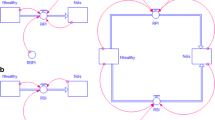Abstract
One of the main goals of the study of plant pathology is the development of methods for reducing crop losses caused by plant diseases. In many crops, growers rely on calendar-based spray programs for disease management. This strategy generally provides adequate disease suppression. However, as it totally ignores the factors governing pathogen development and the occurrence of epidemics, it often results in the application of unnecessary surplus pesticides. Furthermore, occasionally, despite the intensive application of fungicides, diseases develop and yields are impaired. Obviously, this type of spray program is not the optimal strategy for disease management. The contribution of epidemiological research to plant disease management is illustrated in this paper using examples taken from over 15 years of research in Israel. Four case studies are presented, in order of increasing complexity of the pathosystem: ascochyta blight in chickpea, grey mould in sweet basil, powdery mildew in grape and grey mould in greenhouse vegetables. Epidemiological studies of each of these pathosystems have provided new insights into the factors governing disease outbreaks, which have led to the development of improved management strategies. These strategies are currently used by Israeli growers, enabling them to adequately suppress these pathogens with fewer fungicide applications.
Similar content being viewed by others
References
Agrios GN (1997) ‘Plant pathology’. (Academic Press: San Diego, CA)
Dik AJ, Wubben JP (2004) Epidemiology of Botrytis cinerea disease in greenhouses. In ‘Botrytis: biology, pathology and control’. (Eds Y Elad, B Williamson, P Tudzynsli, N Delen) pp. 223–241. (Kluwer Academic Publishers: Dordrecht)
Elad Y, Shtienberg D (1995) Botrytis cinerea in greenhouse vegetables: chemical, cultural, physiological and biological controls and their integration. Integrated Pest Management Review 1, 15–29. doi: 10.1007/BF00140331
Elad Y, Stewart A (2004) Microbial control of Botrytis spp. In ‘Botrytis: biology, pathology and control’. (Eds Y Elad, B Williamson, P Tudzynsli, N Delen) pp. 223–241. (Kluwer Academic Publishers: Dordrecht)
Ficke A, Gadoury DM, Seem RC, Dry IB (2004) Host barriers and response to Uncinula necator in developing grape berries. Phytopathology 94, 438–445. doi: 10.1094/PHYTO.2004.94.5.438
Gadoury DM, Pearson RC (1990) Germination of ascospores and infection of Vitis by Uncinula necator. Phytopathology 80, 1198–1203.
Gan YT, Siddique KHM, MacLeod WJ, Jayakumar P (2006) Management options for minimizing the damage by ascochyta blight (Ascochyta rabiei) in chickpea (Cicer arietinum L.). Field Crop Research 97, 121–134. doi: 10.1016/j.fcr.2005.10.002
Jhorar OP, Bulter DR, Mathauda SS (1998) Effects of leaf wetness duration, relative humidity, light and dark on infection and sporulation by Didymella rabiei on chickpea. Plant Pathology 47, 586–594. doi: 10.1046/j.1365-3059.1998.0280a.x
Kaiser WJ (1992) Epidemiology of Ascochyta rabiei. In ‘Disease resistance breeding in chickpea — Proceedings of the consultation meeting on breeding for disease resistance in kabuli chickpea’. (Eds KB Singh, MC Saxena) pp. 117–134. (ICARDA: Aleppo, Syria)
Ovadia S (2005) Epidemiology of Uncinula necator, the causal agent of grape powdery mildew, and development of a decision support system for its management. PhD Thesis, Hebrew University of Jerusalem, Israel.
Pande S, Siddique KHM, Kishore GK, Gaur PM, Gowda CLL, Bretag TW, Crouch JH (2005) Ascochyta blight of chickpea (Cicer arientinum L.): a review of biology, pathology, and disease management. Australian Journal of Agricultural Research 56, 317–332. doi: 10.1071/AR04143
Pearson RC (1988) ‘Compendium of grape diseases’. (American Phytopathological Society: St Paul, MN)
Sharabani G, Shtienberg D, Elad Y, Dinoor A (1999) Epidemiology of Botrytis cinerea in sweet basil and implications for disease management. Plant Disease 83, 554–560. doi: 10.1094/PDIS.1999.83.6.554
Shtienberg D, Elad Y (1997) Incorporation of weather forecasting in integrated biological-chemical management of Botrytis cinerea. Phytopathology 87, 332–340. doi: 10.1094/PHYTO.1997.87.3.332
Shtienberg D, Vintal H, Brener S, Retig B (2000) Rational management of Didymella rabiei in chickpea by integration of genotype resistance and curative application of fungicides. Phytopathology 90, 834–842. doi: 10.1094/PHYTO.2000.90.8.834
Shtienberg D, Kimber RBE, McMurray L, Davidson JA (2006) Optimisation of the chemical control of ascochyta blight in chickpea. Australasian Plant Pathology 35, 715–724. doi: 10.1071/AP06069
Tivoli B, Banniza S (2007) Comparison of the epidemiology of ascochyta blights on grain legumes. European Journal of Plant Pathology 119, 59–76.
Trapero-Casas A, Kaiser WJ (1992) Influence of temperature, wetness period, plant age, and inoculum concentration on infection and development of Ascochyta blight of chickpea. Phytopathology 82, 589–596.
van der Plank JE (1963) ‘Plant diseases: epidemics and control’. (Academic Press: London)
Author information
Authors and Affiliations
Corresponding author
Rights and permissions
About this article
Cite this article
Shtienberg, D. The contribution of epidemiological research to plant disease management. Australasian Plant Pathology 36, 510–515 (2007). https://doi.org/10.1071/AP07063
Received:
Accepted:
Issue Date:
DOI: https://doi.org/10.1071/AP07063




